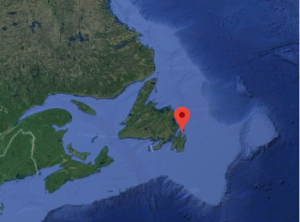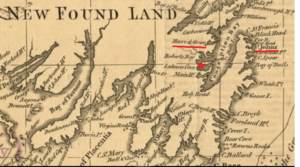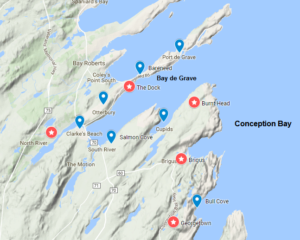This section of the Web Site presents the results of my research and research by others on the Newell family of ‘The Dock’, Bareneed, Newfoundland.
Bareneed is a small village on the northwest shore of Conception Bay, Newfoundland., Canada. There is a separate section of this Web Site dealing with the history of Bareneed and the Dock.

Conception Bay, Newfoundland was one of the first areas of North America to be settled by Europeans. The following Map shows the location of Bareneed (red star) on a 1762 map of southeastern Newfoundland. The locations of St. John’s Newfoundland (Capital of Newfoundland) and Harbour Grace (Harve de Grace) are underlined in red on the Map. Harbour Grace is approximately 20 km north of ‘The Dock’ and historically was the largest town in Conception Bay.

Map of Southeastern Newfoundland 1762
The Dock is the name of the western part of the village of Bareneed which is situated on the isthmus of the Port de Grave Peninsula which extends into Conception Bay, Newfoundland. In historical records ‘The Dock’ was sometimes considered as a separate village (e.g. in early 20th century Newfoundland census records) but in many historical records it was not differentiated from the larger neighboring village of Bareneed. In some cases, both of these villages were considered as parts of Port-de-Grave (a larger town northeast of ‘The Dock’ on the following Map).

Map: Location of ‘The Dock” in relation to surrounding towns.
The following aerial view of the Port de Grave peninsula, taken from above the town of Port de Grave (in foreground) looking inland, shows the location of the Dock in relation to the surrounding towns.

There were fishermen operating from Port-de Grave when John Guy founded the colony of Cupers Cove (now Cupids on map above) in 1610. Salmon Cove at the head of Bay de Grave (shown on 1762 map) is near the mouth of South River and the Guy Colony had a saw mill and grist mill in this area in the 1620s. Up until the mid 20th century Harbour Grace was the largest town in Conception Bay. In 1697 it had 14 houses and a winter population of 100 men but a summer population of more than 500 fishermen from the west of England. By 1715 Harbour Grace was a well established community and the first church (C of E) in Conception Bay was built there in 1764.
The first Newells recorded in Newfoundland were living in English Harbour, Trinity Bay and Bonavista (aproximately 100 km north of ‘The Dock’) in the 17th century..
A census conducted in 1675 enumerated two Thomas Newells: one at English Harbour [Trinity Bay] was married with a son and a daughter, nine men servants, two boats, a stage and a trainvat [for processing oil]; the other at Bonavista with five men, one boat and a stage was not married (see also Francis I. W. Jones, Summer 1999 issue of the Newfoundland Ancestor).
This evidence makes this area a prime candidate for the origin of the Newells of ‘The Dock’; however, none of the researchers who have researched the Newells of this area have identified a link. My father (John Robert Andrews Newell) did suggest that there might be a connection with the Newells of Trinity; however, this might have been through a later marriage.
The first documented Newell living in ‘The Dock’ was my ggg grandfather Philip Newell (Noel, Nuel) who was established there in the 1780s. We have a relatively complete history for Philip (marriage, children, land holdings, death, etc.) but the only information we have on earlier generations is an indirect reference to his parents (James and Anne) .
My quest is to find the roots of the Newells from The Dock started in the early 1970s when I took a undergrad Geography course in rural settlement from Prof. John Mannion. The standard assignment for this course was to prepare a history and genealogy for you family. I guess I fixated on this project and relying on information gathered from my father (John Robert Andrews Newell), other family members (especially Harold Newell, then a retired librarian and teacher) and material in the provincial archives I compiled my first 7 generation genealogy for the Newells in the Dock. Prof. Mannions student papers were archived in the Centre for Newfoundland Studies and in the 1990s I transcribed (from my original hand written version) an abridged version which I made available electronically (See ‘My Early Research‘ sub menu). In the intervening years the core facts presented in this paper have not changed significantly; however, others (e.g. my cousins Ted and Kennith Newell and distant cousin Jane Reed) have filled in detail on later generations and more information is available on the Internet and from DNA so I have prepared a new section on ‘The Early Newells’ incorporating the latest information. This Early Newells paper is the best starting point for anyone interested in my most up to date information on Philip Newell, his children and grandchildren.
The information in this section of the Web Site (”The Dock Nfld’ Tab) is organized into a series of reports as sub menus under the main Tab (hover mouse over any item to see sub items). The following diagram shows the sub menu items under ‘The Dock’.

In addition to the papers on My Early Research and The Early Newells referenced earlier, there are papers on:
- My Immediate Family (details on my parents, grandparents and great grandparents),
- Merchant Connections (research on the merchants associated with the Newells)
- Labrador Connections (research on the Labrador fishery and how it relates to my family)
- WWI (a examination of how World War I impacted ‘The Dock’)
- Notable Newells (stories of some Newells associated with ‘The Dock’).
What has changed since I originally started this research are my views on the origins of the Newells prior to Philip. In my original research I relied on Newell family history and research on the history of the Noel family of Harbour Grace, Nfld. (linked to Newells) compiled by Norman Krischke to deduce that the Newells of the Dock, like the Noels, came from The Channel Islands (Jersey or Guernsey). Today my views have changed due to a combination of research by many others that failed to establish a clear link to the Channel Islands and DNA evidence that seems to point in other directions. However, I still think that there was some link to the Channel Islands either through the Channel Islands being a stop (possibly even for a generation or so) on the journey to Newfoundland or through a maternal connection.